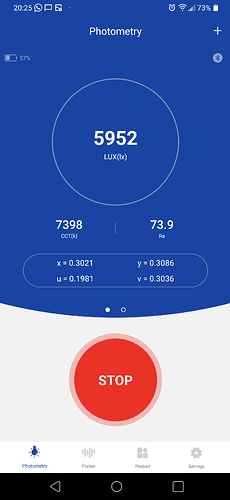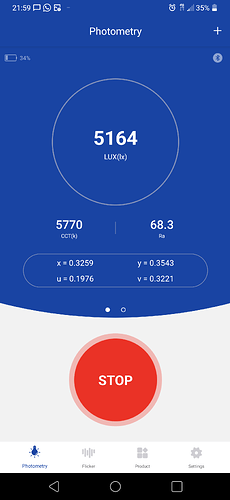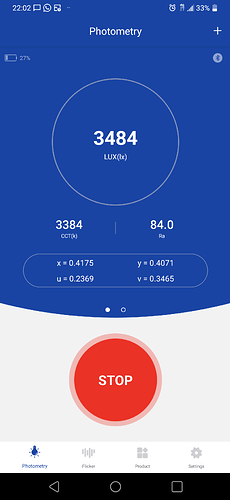LED test / review

Slowly times are changing. Why LEDs from Chinese development used to be mainly blue, inefficient or directly clumsy copies of Western models, very interesting LEDs from previously unknown manufacturers have found their way into the market in recent years.
One of these cases is this “Yinding 5050” LED, which attracted attention some time ago with a circular die. Due to the 5050 format, a good heat dissipation should be given and the luminance should be relatively high.
How exactly, this test will clarify!
Type: single die, domeless (variant with glass cover)
Binning: unknown
Color group: unknown (≈ 5500-6000 K)
Rated voltage: 3.5 to 3.7 V
Max. rated current: 6,000 mA
Rated power: 25 W
Max. absolute current —
Viewing angle: typ. 120°
Thermal resistance: unbekannt
Max. temperature Tj: unbekannt
It is to be noted that no reliable data for this LED can be found. I am also not aware of an official data sheet, so that the above mentioned data should always be with caution!
Already in appearance, the Yinding 5050 differs strongly from most other emitters. As with the earlier Osram LE Q8WP (review here), the luminous surface is covered by a glass surface. This is relatively sensitive; therefore, caution is generally advised when handling this LED. Rough handling must therefore be avoided. On my sample, a “crack” was already visible in the glass right from the beginning, on the picture above on the right. However, this has no influence on the operation of the LED.



The glass coating is equipped with a non-reflective surface (AR coated) to keep luminous flux losses as low as possible.

There are several variants of this LED, the best known of which is also called “Egg yolk type” due to the white wrapping around the yellow luminous surface.
As the number 5050 indicates, the Yinding 5050 is 5.00 x 5.00 mm in size and therefore fits on all XM boards. The symmetrical design allows the use of centering rings made by lathe.
On the side view you can see that the white coating also covers the sides of the light area. This should at least reduce or even prevent unwanted lateral radiation. The luminous surface has a smooth coating, so damage during normal handling is relatively unlikely.

The footprint is also identical to an XM LED. The thermal pad is electrically isolated so that DTP boards can be used without any problems.

A special feature is the round luminous surface. This additionally sets this LED apart from existing models. Round luminous surfaces are known from large COB LEDs, where several small luminous surfaces are arranged in a circular area. In the Yinding 5050 LED, the round luminous surface shines absolutely evenly.
The round luminous surface is 2.39 mm² in size. Due to the classic lateral chip design, no light is emitted to the side. Due to the round shape of the LES, no light is lost due to shading at the wires, despite the use of four bonding wires.

Official data:
- at 6000 mA (official maximum current): 1681 lm @ 3.76 V
- Power at official maximum: 22.56 W
- Efficiency at 6000 mA: 74.5 lm/W
Due to the lack of information and data sheets, the measured data offers little significance. The 25 W (which is sometimes mentioned in offers for the Yinding 5050) is almost reached with about 23 W, so at least the information of 6 A maximum current and 25 W max power is at least somewhat consistent.
The Vf is relatively high, although it is again unclear to what extent it is a series dispersion is unknown. Due to the quite high Vf, DD (direct drive, i.e. connecting directly to a lithium battery without driver electronics) is possible. depending on the voltage situation, operating currents of 6 to 8 A should thus be possible, which is quite realistic when using a Samsung INR21700-40T. It should be noted here that series dispersion can occur and the current in the DD can be significantly higher or lower!
The phenomenon of increasingly rising Vf when approaching the maximum possible operating current is only weakly pronounced here. Usually, the increase is caused by an increasing resistance of the bonding wires, but due to the 4 connections of the luminous surface, this effect does not play a major role, which makes it very unlikely that the wires will burn out even at maximum current.
Overcurrent:
- Maximum reached at 9.40 A, at this point 1957 lm @ 4.25 V
- Power at maximum 39.9 W
- Sweet spot at about 6 A (1681 lm @ 3.76 V)
- Power at sweet spot 22.56 W
- Efficiency at maximum 48.9 lm/W
- Efficiency in the sweet spot 74.5 lm/W
I do not recommend overcurrenting. The power gain is small. Operating at maximum current of 6 A is sufficient, as a gain of only about 20% higher luminous flux in no way justifies almost doubling the power consumption. It seems as if the LED is already operated close to the optimal maximum at the specified maximum current of 6 A, which is relatively unusual compared to many other tested emitters.

The old XP-G2 S4 2B with the smaller luminous surface and the Black Flat are hopelessly beaten here due to their lower maximum current and the smaller luminous surfaces and are no longer up to date, especially since their Vf is considerably higher.
The XP-L HI can keep up with the Yinding in terms of luminous flux, but its luminous surface is significantly larger and the Vf higher, which significantly reduces the possible output under real operating conditions.
Just for comparison: in an old Convoy C8 with SMO reflector (which is not exactly the most ideal lamp for a thrower by today’s standards) the Yinding 5050 could reach almost 200 kLux, the Black Flat HWQP only reaches 180 kLux and the XP-L HI V3 even “only” 135 kLux, each seen at maximum currents possible.

The luminance is extremely high. Already at the specified maximum current, the luminance is higher than the Black Flat HWQP and CSLPM1/NM1!
This luminance was achieved both with the reflector measurement method and with direct measurement at a distance of exactly one meter.
At the maximum current of 9.4 A, I measured the highest luminance of all tested LEDs so far. The maximum current is not practical to achieve, because the Vf is much too high and linear drivers are not usable due to the voltage drop from the battery, but shows what is possible nowadays in terms of luminance!
Just for comparison: in an old Convoy C8 with SMO reflector (which is not exactly the most ideal lamp as a Thrower by today’s standards) the Yinding 5050 could reach almost 200 kLux, the Black Flat HWQP only manages 180 kLux and the XP-L HI V3 even “only” 135 kLux, each seen at maximum currents.

The Yinding LED tested here produces very green light, especially at lower operating currents. A duv of 0.0183 at 350 mA is very high, at 50 mA the duv even rises to 0.0201! The color rendering is also very low, with an Ra of 63, whereas this is quite normal for cool white LEDs with strong color deviation.
Presumably, the green component in the spectrum was raised significantly to improve the overall efficiency of the light output.

As the operating current increases, the duv shifts relatively strongly in the direction of the BBL, which makes the light appear less green. However, the green component is visible at all times. For super throwers, however, this aspect should be of little relevance anyway.

In reflectors, the light image is very good. Depending on the quality and calculation of the reflector, rings can appear around the spot, but the spot is still sharply defined. Spill is only slightly present, most of the light is concentrated in the spot. Color distortions in spot or spill are virtually non-existent.

Due to the round luminous surface, a circular spot also appears when using zoom lenses, which subjectively looks very good, better than a square of known LEDs. Due to the extremely high luminance, an impressive range can be expected, especially when used with lenses.
The Yinding 5050 is an interesting LED. It offers extremely high luminance and thus potential for long ranges, and thanks to the XM footprint it is very easy to replace in existing lamps without having to replace MCPCBs or other centering aids. The circular spot provides a good light pattern in both reflectors and lenses.
Less I like the very green light color and especially the fact that this LED is only available in China and there is no secured information and data sheets about this emitter. Also the Vf is relatively high which makes the use of this LED at maximum currents and therefore maximum luminance quite impossible.
By these factors, I see only one specific use for this LED: in super-throwers, where light quality is not very important and also the limited availability of this emitter does not matter.
Pro
- XM footprint, compatibility with XM accessories
- Very good light image in secondary optics
- Extremely high luminance
Neutral
- DD relatively safe possible
- Overcurrent hardly worthwhile
- maximum current not practicable to use, due to too high Vf
Contra
- Poor color rendering and very green light color
- no reliable information about LED publicly available
- only available in China or from Chinese sellers
Thanks for reading! ![]()
Greetings, Dominik


